
Sarcopenia — age-related muscle loss — threatens a healthy lifespan. With society aging worldwide, the prevalence of sarcopenia increases the urgent need to establish prevention and intervention strategies. The U.S. Centers for Disease Control and Prevention now recognizes sarcopenia as an independently reportable medical condition.1
Analysis by Dr. Joseph Mercola
STORY AT-A-GLANCE
- Sarcopenia — age-related muscle loss — threatens a healthy lifespan. Skeletal muscle not only manages physical activity, but also plays a major role in metabolism, circulation and cognition
- Skeletal muscle acts as endocrine organ secreting myokines and transcription factors into the bloodstream, thereby regulating the function of other organs. It also has immune regulatory properties
- The loss of muscle mass with advancing age is thought to be a primary driver of insulin resistance in older adults. Declining muscle strength and reduced physical activity also contribute to metabolic dysfunction
- Four key lifestyle strategies that have allowed me to get stronger with age are time-restricted eating in combination with a cyclical ketogenic diet, exercising while fasting and adding blood flow restriction (BFR) training to my strength training routine
- While doing any one of these in isolation would likely improve your health, when done in combination, they really catalyze synergistic changes that optimize your ability to gain muscle and lose visceral fat
This article was previously published January 01, 2021, and has been updated with new information.
Your Skeletal Muscle Has Many Functions
Sarcopenia — age-related muscle loss — threatens a healthy lifespan. With society aging worldwide, the prevalence of sarcopenia increases the urgent need to establish prevention and intervention strategies. The U.S. Centers for Disease Control and Prevention now recognizes sarcopenia as an independently reportable medical condition.1
Many don’t realize that skeletal muscle not only manages physical activity, but also plays a major role in metabolism, circulation and cognition, as seen in the following figure.
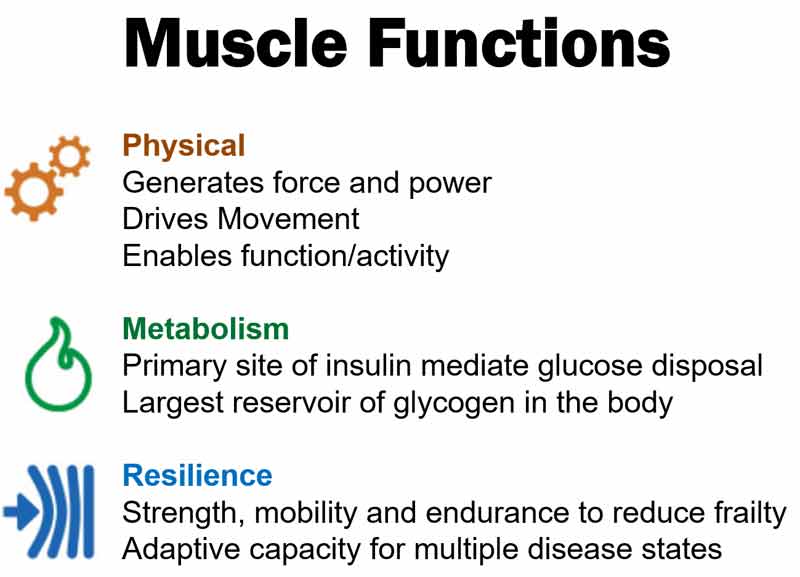
Skeletal muscle not only functions to generate force and movement, but it is now known that your muscles actually serve an important endocrine function. They secrete special cytokines (i.e. myokines) and transcription factors into the bloodstream, thereby regulating the function of other organs. Furthermore, skeletal muscle is a metabolically active tissue with an important role in the maintenance of metabolic homeostasis.
Skeletal muscle is the most abundant tissue, comprising 40% of your body mass,2 and is the primary sink of insulin-mediated glucose disposal. Muscle is also the major site for insulin-stimulated glucose uptake, as well as the main energy consumer of fat.3 After meals, about 80% of glucose is deposited in your skeletal muscle.4,5
How Sarcopenia Sabotages Your Health
The loss of muscle mass with advancing age is thought to be a primary driver of insulin resistance in older adults.6 The declining muscle strength and progressive mobility impairment with age also likely causes a reduction in daily physical activity which can contribute to metabolic dysfunction.7,8
The loss of resilience as a result of sarcopenia is underappreciated as a major factor in the ability to recover from life’s inevitable challenges. It is clear that elderly with low muscle mass experience delayed recovery,9,10 and have higher rates of complications and infections following surgery,11 greater drug toxicity12 and higher disease-specific and all-cause mortality.13
Sarcopenia also predicts both the risk for community-acquired pneumonia in the elderly,14 as well as 90-day mortality in patients suffering from aspiration pneumonia.15
Muscle is increasingly recognized as an organ with immune regulatory properties. As such, skeletal muscle cells modulate immune function by signaling through different soluble factors, cell surface molecules or cell-to-cell interactions.16 It is also speculated that sarcopenia contributes to immunosenescence — the gradual deterioration of your immune system — which is a leading cause of death in the elderly.17
Additionally, recent reviews found strong evidence that frailty due to sarcopenia18 is a risk factor for adverse outcomes, such as longer hospital stay, functional decline at discharge, and both in-hospital and medium, lower quality of life,19 and long-term mortality.20
My Strategy and Recommendation to Combat Sarcopenia
Now, I am no stranger to exercise. I have been exercising since 1968, which is 52 years. The problem is that the first 43 years were exclusively cardio, and in my case long distance running. I like to compete, so I got relatively decent and was eventually able to run a 2:50 marathon, which was good enough back then to get me on the post-graduate University of Chicago Track Club.
Unfortunately, I didn’t realize that while cardiovascular exercise can lower your risk of heart disease, it is a highly catabolic activity and will actually lower your ability to build muscle. Below is a picture of me taken during my peak running condition. As you can see by the arrow, I had a gigantic 10.5-inch arm circumference.
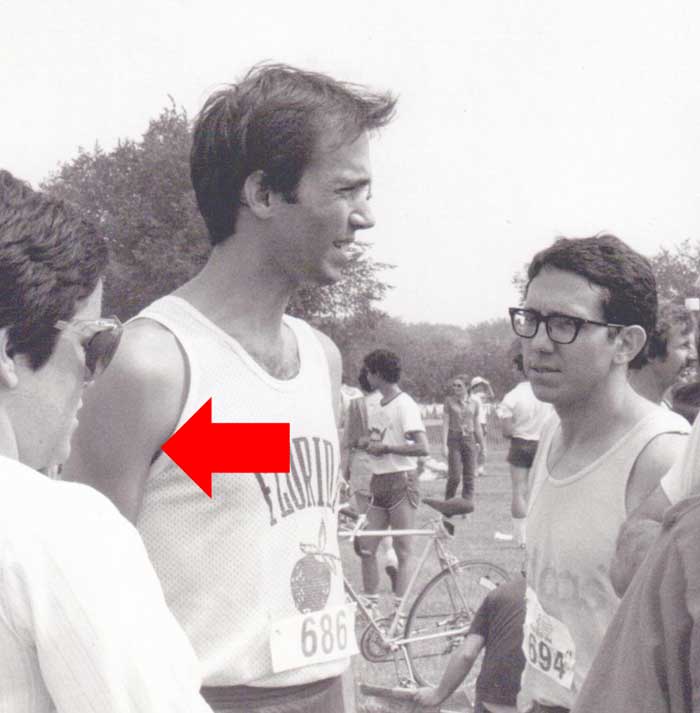
Contrast that to the picture below, taken December 8, 2020, where my arm circumference is 15 inches. I had just finished doing a PR video for the deadlift at 370 pounds. The video (below) was posted to Instagram on the same date.
The blue plates are 45 pounds each; the black ones are the same width as the blue ones, but are plastic and are 25 pounds; and the bar is 50 pounds. My team wanted me to do a story on how I did this to, hopefully, inspire you to similar, if not better, levels of strength.

What Caused the Change?
The simple answer to this question is that I ditched my cardio and started resistance training. It is important to note that these changes did not occur overnight, so please don’t expect immediate results. I was well over 50 when I first started and I’m now 67. It requires consistency and dedication; however, I will share a few tricks that should significantly cut your time to get results.
First, let’s explore the exercise changes. For the last dozen years or so, I have not run at all and have used resistance training as my primary exercise training. I probably lift weights about five hours a week, but I also spend the same amount of time in a variety of stretching and general body movement exercises, so it is a balanced program.
It is key to always have significant recovery period to allow your connective tissue and muscles to recover. That is why I only deadlift once a week or less. Although this is a fabulous total body movement, any exercise done in excess can cause you to get injured and force you to stop exercising.
I made this mistake with wide grip pullups. I used a weight belt with 25 pounds to build my strength so I could eventually do 20 pullups. Unfortunately, I was doing this six or seven times a week and never gave my body enough time to recover. So, I wound up injuring my anterior deltoid muscle, which prevented me from doing that exercise for several months.
I have a regular personal trainer who guides me through these exercises, but he occasionally leaves for a month, and with COVID-19, I didn’t see him for three months, which wasn’t a problem.
If you can’t afford a trainer, there are many GREAT free videos on YouTube that can guide you in lieu of a personal trainer. My favorite YouTube exercise channel is ATHLEAN-X, which has 11 million subscribers, but there are many excellent channels that will teach and guide you for free.
Remember that if you are doing resistance training, avoid doing the same exercise every day to allow your body time to recover and repair so you will get the benefits and avoid injuries.
Food Choices Are Vital to Get These Gains
My understanding of optimizing nutrition for health has been a greater than five-decade journey. At the beginning, I fell into the low-fat diet myth and thought I was eating healthy with my grains and margarine alternatives, but I was fooled. The key here is that I was motivated to make the right choices: I simply lacked proper mentoring and information.
That was one of the primary reasons I started this website over two decades ago. I believed that people didn’t need to make the same silly mistakes I made, and by sharing my insight I could save them needless pain and grief.
Another major mistake was the lack of appreciation of never taking time off from eating. It seemed to make sense that you need to eat around the clock, and that going without food for days could wreck your health by losing muscle mass from inadequate protein intake.
After researching this, I realized it was seriously wrong and actually highly counterproductive. Your body actually requires regular intervals where you aren’t eating and failing to do so is a prescription for metabolic disaster.
Research by Satchidananda Panda, Ph.D., suggests 90% of people are eating more than 12 hours per day, and perhaps 50% of the population eat up to 16 hours a day. There are even many that wake up in the middle of the night to eat.
This is perfectly understandable as you need fuel to run your body and most people, as I wrote extensively in my bestselling book, ”Fat for Fuel,” are using carbs, not fat, as their primary fuel. Since your body has a minute supply of stored carbs relative to fats, you simply need to eat far more frequently to avoid feeling ravenously hungry and tired as your body runs out of fuel.
Time-Restricted Eating Is a Key Health Principle
One of the most important health principles is time-restricted eating (TRE), which is a form of intermittent fasting. Contrary to modern belief, your body isn’t designed to be fed throughout the day, and the near-continuous grazing that most engage in can have serious health consequences.
When you eat throughout the day and never skip a meal your body adapts to burning sugar as its primary fuel, resulting in the downregulation of enzymes that utilize and burn stored fat.21,22 As a result, you become progressively more insulin resistant and start gaining weight.
Many biological repair and rejuvenation processes also take place while you’re fasting, and this is another reason why all-day grazing triggers diseases while fasting prevents them.23
There are a number of different intermittent fasting regimes, some of which are more extreme than others, but all are based on the premise that you need to fast for periods of time. TRE is one of the easiest to follow as you simply abstain from food for 16 to 18 hours a day and eat all your meals within a window of two to eight hours. A four- to six-hour window is likely close to metabolic ideal for most.
By restricting the timing of your meals so that you’re fasting for a greater number of hours than you’re eating, your body will, over time, learn to burn fat for fuel again, rather than relying on fast-burning carbs. Eventually, you’ll also start accessing and burning stored body fat.
While TRE will shift your body from carb-burning to fat-burning by itself, it’s more effective when you’re also eating a cyclical ketogenic diet.
Help Build Muscle by Combining TRE With Exercise
With respect to exercise, the ”magic” formula is to exercise while you are fasting. For most, this means not eating at least three hours before bedtime and exercising first thing in the morning, before breakfast.
The reason you do this is because the mTOR anabolic pathway is maximally suppressed when you are fasting, and suppresses even further with exercise. The mTOR pathway can be likened to a coiled spring — you compress it, and then you eat food and it explodes into action.
mTOR is the signal your body uses to build muscle mass. It really is the key. You need to radically stimulate mTOR to build muscle tissue. You really only want to do this once a day, though, because if you are constantly activating mTOR, you will increase your risk of cancer.
The other factor that activates mTOR is branched chain amino acids. Leucine appears to be the most potent, with hydroxy methyl butyrate (HMB) — a leucine metabolite — being the most potent of all. Below is a table of foods with the grams of leucine per 100 grams of the protein:
| Food | Leucine |
|---|---|
| Whey Protein | 10-12 grams |
| Beef | 1.8 grams |
| Salmon | 1.6 grams |
| Eggs (3 eggs) | 1.4 grams |
So, immediately after your resistance exercise, you’ll want to have at least 3 grams of leucine or HMB. This will give your body the optimal anabolic stimulus to increase muscle protein synthesis to boost your muscle mass.
There are other foods that have leucine, like almonds, chicken and soy protein powder, but I don’t recommend them as they have high amounts of the omega-6 fat linoleic acid. If you are over 60 or have kidney impairment, I also don’t recommend whey protein as it is high in phosphate, which can impair kidney function.
So, it seems the safest strategy is to take a supplement. You can take branched chain amino acids, essential amino acids or simply HMB, as long as you are getting 3 grams after your workout, as that will maximally activate mTOR. Remember, more is not better, and will not stimulate it more. All you need is 3 grams.
The BEST Strategy I Know of to Increase Muscle Size
There are loads of ways to increase your muscle mass but they mostly involve moving, pushing or pulling heavy weights or resistance bands. The problem with this strategy is that if you are not in good shape, and especially if you are elderly, there is a very high likelihood that you will get injured. In most cases, it is not if you will get injured but when.
The answer to this problem is an exercise strategy known as blood flow restriction training or BFR. As the name implies, BFR involves modifying the arterial inflow and venous outflow while you’re working the muscle by placing an inflatable band around the extremity.24
I have done many things in the last 10 years to help build muscle mass, but I believe combining TRE with mTOR activation and BFR is largely responsible for producing the changes you see in my video above.
How BFR Works
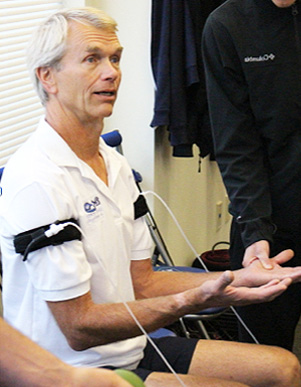
BFR’s ability to achieve such remarkable physiological benefits is directly related to slowing venous blood flow from the muscle group being engaged and creating a relatively hypoxic environment or low oxygen pressures in the exercising muscle.
Venous flow moderation is optimally achieved by wrapping the extremity being exercised with an inflatable cuff or band. The band needs to be tight enough to slow venous return to the heart, allowing venous blood to ”pool” in the region of the limb that is being exercised, while loose enough to allow arterial blood to flow through.
With very light exercise, and in about 15 to 20 minutes, you get an exhaustive workout that sends a signal to your brain that says, ”Hey, I’ve done something really hard here — you better help me recover and adapt to it.”
Your brain then sends out hormonal responses that cause your muscles and blood vessels to grow. Most would think that such light weights would be insufficient to provide any muscle strength improvements, but studies show a 36.2% to 40.1% increase in muscle strength after only 12 weeks, depending on your load and health.25
BFR Mimics Heavy Weight Training Without Any of the Risks
BFR training is frequently misunderstood as simply a conventional resistance training program with the addition of resistance bands. Nothing could be further from the truth.
Because the exercise is done with such low weights, there’s far less muscle fiber trauma and damage; especially relative to conventional strength training. This means you are able to recover much quicker, so you don’t have to dig yourself out of a hole the next few days. In most cases, you can exercise different body parts nearly every day and rapidly attain the metabolic and physical benefits.
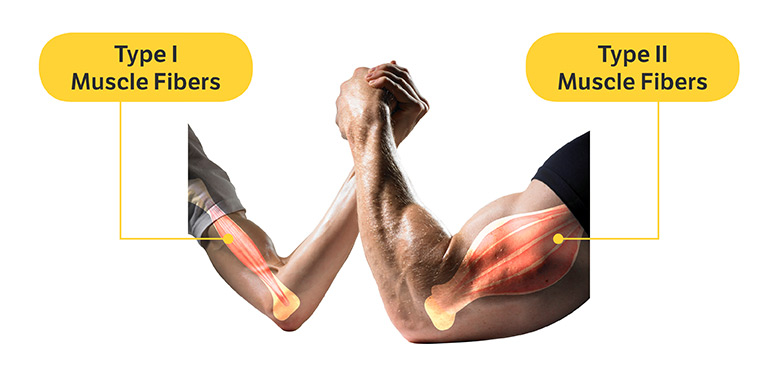
High intensity training such as sprinting or heavy weight training have typically been recommended for increasing muscle size because they activate the fast twitch Type II muscle fibers.
In order to increase muscle mass and strength, it’s important to activate Type II muscle fibers during training, since these fibers have been shown to be more responsive to hypertrophy than Type I fibers26 and are generally much larger.
Weight training done at low weights will not activate Type II fibers — unless it’s done with BFR. The reason for this is because the Type I fibers become exhausted in the hypoxic conditions created by BFR, which then allow the Type II fibers to fire and generate high levels of lactate, which are responsible for much of the metabolic magic.
During BFR training the Type I fibers become highly fatigued during the first set, thus necessitating the recruitment of Type II fibers as the exercise progresses.27 Simply moving light weights with high repetition without BFR will not engage Type II fibers because there is plenty of oxygen for the Type I fibers to work. Hence the fast-twitch Type II fibers just aren’t called into action.
This is the type of training that not only will add solid muscle mass, but also significantly increase your strength and endurance while reducing your body fat. For most people who are not competitive athletes, it’s really the only form of resistance training they need.
Competitive athletes also seem to benefit from BFR, but they would need to combine it with conventional strength training.28 In short, BFR works on a very simple principle: It tricks your body into believing that it’s moving far heavier weights than you’re actually using, and as a result generates compensatory metabolic responses, detailed below.
Local and Systemic Effects of BFR
If you are elderly, what is really amazing is that your muscle growth with BFR is beyond what strength training with heavy weights can do. This is because you need good blood flow to your Type II muscle fiber stem cells, and virtually everyone’s microcirculation decreases with age. So, even if you send the signal to grow by doing conventional strength training, it won’t work as well if there isn’t enough capillary supply to your Type II fiber stem cells.
BFR increases your microcirculation, your capillaries and venules and arterioles that are associated with them (see image below), largely because your muscles are working in a hypoxic (low oxygen) environment.
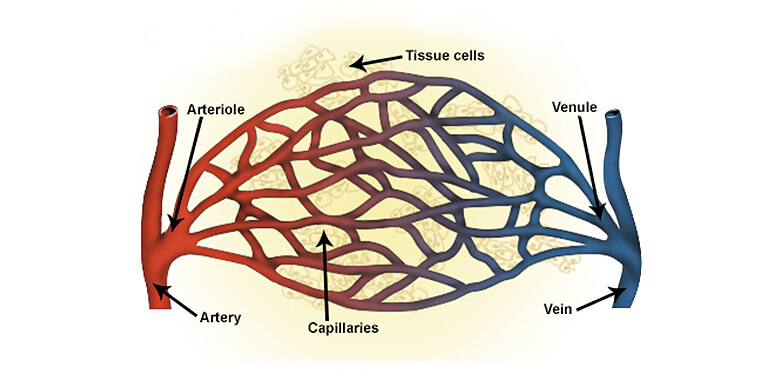 Microcirculation
Microcirculation
BFR Increases Microcirculation
This low oxygen tension causes the release of hypoxia-inducible factor-1 alpha (HIF-1 alpha),29 that then increases the hormone vascular endothelial growth factor (VEGF), which is one of the most powerful angiogenic signals in your body. BFR has been shown to raise VEGF levels by 410% in young adults.30
Essentially it acts as ”fertilizer” for growing new blood vessels and capillaries to your muscle stem cells. BFR training has been shown to increase muscle stem cells by 300% after eight days of training.31 But it gets even better, as VEGF not only increases microcirculation in your muscle stem cells but also in your brain and heart. In Japan, BFR is frequently used for stroke and cardiac rehab precisely for this purpose.
BFR also increases the production of the important regulatory free radical, nitric oxide (NO), which further contributes to an increase in VEGF.32 NO is an important signaling molecule produced at high levels in muscle by neuronal nitric oxide synthase (nNOS). BFR, by way of increasing NO, has been found to stimulate muscle satellite stem cells and proliferation.33
BFR Is a Powerful Myostatin Inhibitor
But here’s the real winner: BFR also downregulates a hormone called myostatin, which is a negative regulator of muscle growth and mass.34,35,36 In other words when your myostatin levels are high you simply are unable to grow muscle. This is important because the elderly have levels twice as high as the young.37
In the past, lactate was traditionally viewed as a metabolic waste product, but today it is understood that lactate is an important molecule that is responsible for many metabolic processes and results in many structural adaptations. It is even referred to as a pseudo-hormone.38
When you apply the bands and engorge the working muscle, the Type I muscle fibers which require oxygen, glucose and fat to create energy in the mitochondria rapidly give out and your muscle switches to Type II fibers that run on burning glucose without oxygen by the glycolysis pathway illustrated below.

The lactate that your Type II muscle fibers generate during BFR actually down-regulates the production of myostatin and helps improve skeletal muscle loss. Amazingly, BFR can decrease your myostatin levels by 41% to 45%, which has been shown to increase muscle protein synthesis.39,40,41,42
The benefits from the lactate don’t stop there. Once you release the bands, the lactate travels in your blood to your brain, where a monocarboxylate transporter shuttles it into your brain to use it for fuel,43,44 and also increases brain derived neurotropic factor (BDNF).45 BDNF is a member of brain growth factors that contributes to neuroplasticity, which greatly enhances cognitive performance.46,47
Correct Band Pressure Is Crucial

As mentioned previously, the restriction bands need to be tight enough to lower the oxygen level in the exercising muscles. Arterial occlusion pressure (AOP) is defined as the pressure needed to restrict 100% of the blood flow from the limb,48 which is essentially a tourniquet. This is a dangerous scenario and needs to be avoided.
Recent research49 has shown the pressure only needs to be 60% of the AOP. Pressures higher than this don’t seem to provide any additional benefits. The level needs to be at least 40% of AOP; otherwise, the level of muscle oxygenation and deoxygenation is not substantially different from that seen during non-BFR exercise.
Recent studies suggest that the ideal range is about 60% of AOP,50 although this is highly dependent on numerous factors such as fundamental vascular elasticity and the type of exercise being performed (e.g., anaerobic versus aerobic). There are no additional benefits of combining higher exercise intensities with higher occlusion pressures to muscle hypertrophy.
Again, the bands should not be too tight, as you definitely must avoid cutting off the arterial supply to your muscles. They need to be loose enough to supply your muscle with sufficient blood flow and oxygen.
When manually applying the bands, tighten them so your skin color becomes more pink or red compared to your normal skin tone. You may also see your veins become slightly distended (popping out a bit). They should not feel uncomfortable and your skin color must not become whiter or have a bluish or grayish tone; this means that arterial flow is being restricted.
It is important to realize that your arms will swell during the exercise, which will actually tighten the bands more. Remember, another simple way to determine good ”base pressure” is to have the bands tight enough that you cannot fit two fingers under the band, but loose enough that you CAN squeeze one finger under the band.
However, if the pressure is below 40% of AOP you will not occlude your veins. This will prevent the lactic acid produced during your exercise from accumulating, and you will not get the benefits.
One of the ways you can confirm that your bands are tight enough is to measure the circumference of your limb before and after the exercise. You should notice an increase of at least one-half inch to 1 inch after your exercise, up to as much as three or four times that.
How to Confirm Proper Pressures
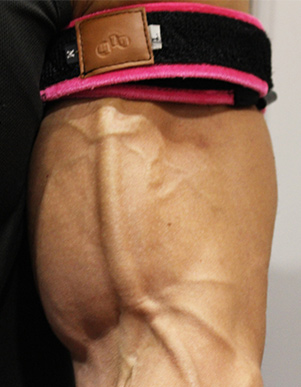
If the bands are too tight you can actually cause damage to your muscle. It’s important to carefully monitor your capillary refill times to confirm you are getting enough blood flow to your exercising limb. You can confirm that you have enough arterial flow by checking your capillary refill time.
When checking proper band pressure on your arm, it is most easily determined by pressing your index finger firmly into the palm of the opposite hand (on the arm that is under restriction) into the area just under your thumb, then quickly releasing and seeing how long the white blanched area takes to turn pink.
If it takes longer than three seconds, the bands are too tight. If the white spot turns pink immediately while the pneumatic bands are inflated (i.e., under one second), the band tightness is close to optimal. You can also check the capillary refill time on the tissue right above your knee while the pneumatic bands on your legs are inflated. Ideally it should be about two to three seconds.
If you have peripheral artery disease, this could affect these readings. If it is less than two seconds the bands are likely too loose; if the time is greater than three seconds the bands are likely too tight.
!Warning
To avoid any muscle damage from your limbs being deprived of oxygen, the bands are only put on the arms for 15 minutes at a time or 20 minutes on your legs.
Only put the bands on the extremities you’re actually exercising, and remove them before moving on to the next area. In other words, you must not conduct simultaneous BFR on both your arms and legs, as this could decrease your blood pressure enough that you might pass out.
Remember, whatever bands you use, KAATSU or less expensive BFR bands, the pressure that the cuff is inflated or tightened to should not be painful or cause any numbness. You will know if it is too tight as they will likely hurt. They are not supposed to shut down your arterial supply. If it is too tight you need to lower the pressure or loosen the bands.
How to Determine Your Ideal Level of Resistance
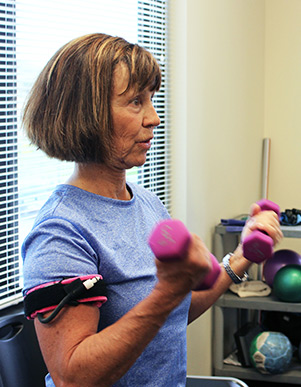
Instead of using heavy weights that can increase your risk of injury during conventional strength training, BFR is much safer, since it requires just 20% to 33% of the resistance used in conventional resistance training.
This light weight is then combined with a high volume of repetitions while externally applied compression mildly restricts blood flow to the active skeletal muscles in the legs or arms.51
As for weight, your goal is to find the ”sweet” spot. If you are elderly or have not been exercising regularly, this may mean no weights at all. Ideally, you would have access to a variety of progressively increasing resistance movements to choose from, including body weight exercises. You typically won’t need to go higher than 25 pounds, though.
Once you have access to the weights you can find the heaviest weight you can do just one repetition of your planned exercise. This is your one rep max (1RM). Then you divide that weight by five (20%), four (25%) or three (33%). For example, if your max weight for a bicep curl is 25 pounds, you would select a 5-pound dumbbell to start.
If you don’t know your one rep maximum, then it is always better to start too low, especially if this is your first time, as your tissues will need time to adapt to these pressures and movements. Eventually you will want to increase your weight so you notice the following signs during your BFR session:
|
Signs That You Are Using the Correct Weight
You can measure the circumference of your limb before and after the exercise. You should notice an increase of at least one-half inch and possibly 1 inch or more — or alternatively, the muscle will most certainly feel tighter and appear more toned. Another great indication is that you will be able to do 30 reps the first set and then 15 to 20 reps the next and, most likely, are unable to do five to 10 reps in the last set because you are in muscle failure. It is important, though, to not fool yourself and stop just because it is hard. Muscle failure means that you are unable to do another rep if your life depended on it. |
Unless you are just starting (see warning box below), it is best to start by limiting your weight to only 20% of your one rep max and build up from there if your goal is muscle hypertrophy. By starting at a lighter weight, it will give your body a chance to adjust to BFR and avoid potential injuries.
An additional benefit is that if you stick with lighter weights you can train more frequently because you won’t cause as much muscle damage. For those interested in greater strength or muscle gains, you can increase to one-quarter and then to one-third the weight of your 1RM. If you are doing the exercises correctly it will likely take you about three months to progress up to 33% of your 1RM. There is no need to go any higher than this.
If you don’t know your 1 RM, then all you have to do is pick a weight you believe you can easily do 30 reps with and start there.
If you can easily do all three sets at that weight, then it’s clearly too low a weight and you would benefit from increasing the resistance, especially if you don’t notice an increase of at least one-half inch in the circumference of your biceps after the exercise. Conversely, if you are unable to complete 20 repetitions on your first set, the resistance is likely too high and needs to be decreased.
!WARNING FOR FIRST-TIME USERS
The only exception to these weight recommendations and initial pressure of the bands is when you are first starting out. It is important to realize that your tissues need time to adjust to BFR training. For the first session, you want to start with a light pressure, likely under 40%, and use only 10% of your 1 RM. Then over the next two sessions increase to the minimum recommendations.
Important: You Need to Push Hard to Get the Benefits
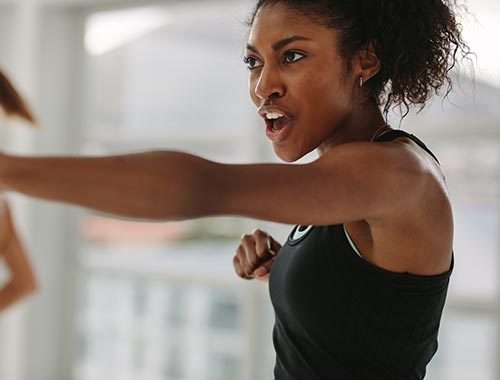
It is important to recognize, though, that the level of intensity you use is key. Muscle growth is highly dependent on metabolic factors, and training sets are ideally done to failure to achieve this.52,53
The number of repetitions completed during a training session is less important to cause long term changes in hypertrophy and strength than doing repetitions to failure, which likely causes greater metabolic stress.
Perceived exertion is a major element here. You really need to push hard to muscle failure. This is a very subjective determination, but I hope the featured video will give you an idea of the amount of intensity and effort one needs to put into this short exercise.
You can also notice if you are sweating and you are out of breath. Since BFR is a high intensity exercise and stimulates your sympathetic nervous system if done properly, this is precisely what you should be experiencing when you do BFR training.
A recent study in the elderly showed that physical weakness in aging may be due, at least in part, to impairments in brain and nerve function, rather than changes in the muscles themselves.54
The researchers did the study by asking participants to push to failure and once they said they had, they stimulated the muscle electrically and where still get the muscle to contract which indicated that the muscle was not at full failure. In fact, in most cases the muscle was still able to contract about 25% more.
If you are unable to push to failure, you will not receive the maximum benefits possible from BFR. Also, shorter recovery periods between exercises and sets will heighten the metabolic stimulus to enhance your body’s ability to build muscle and strength.55
Remember, you can start slowly and work your way up over time. Building muscle is a marathon, not a sprint. This is especially important if you are elderly or if you have been mostly sedentary; you likely will not need to use any weights.
You can start with just the weight of your body and gradually progress to 1- and 2-pound weights. But if you really are interested in triggering the benefits of reversing sarcopenia, then it is key to push hard — otherwise you will not achieve all the wonderful metabolic benefits that BFR has to offer you.
General BFR Workout Guidance
Although you can adapt BFR training to many types of resistance training including machines, it seems the ideal way to implement it is by using simple dumbbells. Because you are using such low weights, it is unlikely you will need weights more than 25 pounds. If you are elderly and weak you may only need a set of weights under 5 to 10 pounds.
Please be certain that you can increase weights in very small increments. You will not want to increase an exercise from 5 pounds to 10. That is a 100% increase in weight. It is far better to go up by 1 or 2 pounds.
|
Number of Repetitions in Each Set 1st set = 30 reps with 20 seconds rest for arms and legs 2nd set = 20-30 reps with 20 seconds rest for arms and legs 3rd set = 10-20 reps with 20 seconds rest for arms and legs 4th set = 1-10 reps with 20 seconds rest for arms and legs and 60 seconds maximum before moving to next exercise |
A common beginner mistake is to remove or loosen the band during the workout to allow the blood to flow back to your muscle and then tightening it again. This does not improve results, and in fact decreases your results, so it is best to leave the band on during the entire workout.
Just remember to remove the bands after 15 minutes on your arms and 20 minutes on your legs. You can reapply the bands after a minute and exercise if you want to do more exercises.
If there is pain or numbness or a whiter appearance in your skin color, of course you’ll want to remove or loosen the band at once, but that should be unusual if you have done your preparation properly and paid careful attention to these instructions.
Typically, upon starting BFR, you’ll notice a high perceived degree of difficulty. However, over a few weeks this perception of difficulty dampens as adaptation to training occurs.56 At that point, it becomes important to continue to push with the same level of intensity.
Training Frequency
One of the major advantages of BFR versus high load resistance training is that you cause far less muscle damage and this allows you to train more frequently. The frequency of training needs to be individualized as it varies widely. It can range from as little as twice a week up to three times a day, depending on your fitness and training goals.
Typically, the lower the percentage of 1RM used, the more frequently BFR can be done.57 Heart rate variability and the Oura ring can also be used to determine your ideal recovery periods. The Oura ring measures your heart rate all night and will tell you not only your lowest heart rate but also at what time it occurs. The higher your heart rate and the closer your lowest heart rate time is to awakening, the more recovery you need.
Less Expensive Alternatives
Although KAATSU was the pioneer in BFR, their units are relatively expensive. The advanced KAATSU Master unit used by professional teams, the U.S. military, hospitals and medical professionals costs up to $6,000, while their newest consumer version is available beginning at $899.
This is because they use thin, algorithm-controlled, pneumatic bands that automatically pressurize around your upper arms and legs to slow the amount of blood flowing back from the muscles in your extremities. These bands may look like very thin blood pressure cuffs but they serve an opposite function.
The major advantage of the KAATSU automated system is that it can do cycle compressions — compressing the limb for 30 seconds and then relaxing for five seconds. Over the course of eight rounds of compressions, the device will progressively increase the pressure for each cycle. The pressures can also be easily adjusted from very low to high.
If you can afford the KAATSU set, that would be ideal as it is far easier to dial in to the correct pressures. With the KAATSU system you can control the tightness in two ways. The initial tightness is after you manually tighten the bands.
This is the base pressure and typically around 10 to 25 mm/Hg for the arms and 15 to 35 mm/Hg for the legs depending on your age, vascular elasticity and physical condition. The inflation pressure is what you set the compressor to pump the cuff up to. This ranges from 80 to 400 mm/Hg for both the arms and legs.
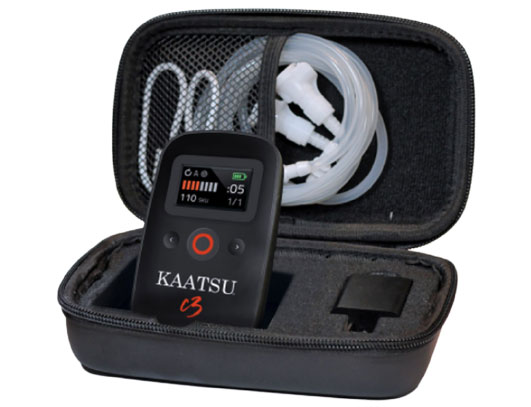
If the KAATSU system is outside your budget, there are a wide range of inexpensive BFR bands available. Just be aware there are many inferior versions out there. You need to be careful and make sure the material is elastic and can stretch. Additionally, make sure that the bands are only 1 1/2 inches wide for the arm bands and 2 inches for the leg bands. The ones I recommend are here.
Remember, while there are many 2-inch BFR bands for the arms for sale, these bands are too wide and may cause ischemic injury and must be avoided. Also, wider cuffs require significantly less pressure to achieve arterial occlusion pressure,58 so it’s easy to end up with excessive arterial occlusion with wider cuffs which, again, is not recommended.59
The other danger of using bands that don’t stretch or are too wide is that they will increase your blood pressure far higher. Under these circumstances BFR can be dangerous and increase your blood pressure too high and may actually cause a stroke.
Not to worry, though, because if you use the elastic stretchy bands that are the correct width (1 1/2 inches for the arms, 2 inches for the legs), there is essentially no risk of stroke. This is because correctly performed BFR will actually lower your blood pressure. It is the finest exercise I know of to release nitric oxide and is far more effective than the nitric oxide dump I used to do.
How to Perform BFR

Begin by applying the bands to your upper arm, very close to your armpit, just where your bicep muscle begins and deltoid muscle ends. On your legs, you can apply them right below your hips at the top of your quads, close to your groin.
There are misconceptions that you need to put the bands close to the muscle you are seeking to focus on, but this is unnecessary and a mistake.
There is a crossover training effect and your muscles that aren’t blood flow restricted will also receive benefit once you release the bands after training. In other words, you will gain benefits in your chest muscles even though you are only restricting your arm muscles.
Also, do not put the bands over your knees or elbows, as this could cause nerve damage. Only put the bands on your body as described above because the goal of BFR is to increase your vascular elasticity and elicit a metabolic and hormonal response that ultimately leads to aesthetic and muscular improvement.
When you engage in the exercise properly, lactic acid will accumulate in the muscle, which will be associated with a burning-like pain due to the excess hydrogen ions being produced. It will clearly be uncomfortable, especially as you push to muscle fatigue. It is important to understand that this subjective sensation of discomfort will improve with time.
It will likely take four to six weeks to develop the strength and hypertrophy gains. Once achieved, a study60 in elderly participants showed that doing BFR training twice a week was sufficient to maintain the gains. When training decreased to once a week, the gains failed to be maintained.
If you are able to there is benefit to doing BFR every day. You can just vary the number of exercises you do per day. It could be as simple as applying the bands to your legs and walking for thirty minutes, or putting them on your arms and swimming. It doesn’t have to involve weights as you can also use them in your favorite sport; you just need to use the same time restrictions discussed above.
Get Stronger and Healthier With Age
In summary, the four key lifestyle strategies that have allowed me to get healthier with age are TRE in combination with a cyclical ketogenic diet; exercising while fasting; and adding in BFR to my strength training routine. While doing any one of these in isolation would likely improve your health, when done in combination, they really catalyze synergistic changes that optimize your entire system.
The best news of all is that it’s never too late to start. My transformation began in my 50s, and I feel better now at 66 than I did back then. You can transform your health and physique too. You just have to get started, and keep going!
Analysis by Dr. Joseph Mercola
- 1 Fed Pract 2017 Jul 9;34(7):24-32
- 2 Cell Metab 2009 Dec;10(6):507-515
- 3 Cell Biol. 2005 Oct;37(10):2047-63
- 4 Diabetes 1982 Nov; 31(11): 957-963
- 5 N Engl J Med 1990; 322:223-228
- 6 Diabetes Care 2009 Nov; 32(suppl 2): S157-S163
- 7 J. Gerontol. A Biol. Sci. Med. Sci. August 2018; 73(8): 1070-1077
- 8, 18 Redox Biol. August 2020; 35:101513
- 9 Surg Today. 2018; 48: 151–157
- 10 Ageing Research Reviews 2018 Nov;47:123-132
- 11 Liver Transpl. 2013 Dec; 19(12): 10.1002/lt.23752
- 12 Clin. Cancer Res. 2009 Apr 15;15(8):2920-2926
- 13 Cancer 2014 Sep 15;120(18):2910-2918
- 14 Arch Gerontol Geriatr. May-Jun 2019;82:100-105
- 15 J Am Geriatr Soc. 2017; 65: e18–e22
- 16 Autoimmun Rev. 2018; 17: 518–529
- 17 EBioMedicine. 2019 Nov;49:381-388
- 19 Age Ageing. 2019; 48: 16–31
- 20 Ageing Research Reviews 2019 Dec;56:100960
- 21 Cell February 8, 2018; 172(4): 731-743.E12
- 22 Medical News Today February 8, 2018
- 23 Science November 16, 2018; 362(6416): 770-775, Page 1
- 24, 51 Frontiers in Physiology 2019; 10: 533
- 25 Front Physiol. 2019; 10: 446, Discussion: Muscle Strength
- 26 J Appl Physiol. 1996;81(5):2004–12
- 27 Acta Physiologica 2019 May 20:e13302 [Epub ahead of print]
- 28 J Hum Kinet. 2018 Dec; 65: 249–26
- 29 Cell 2019 Mar 7;176(6):1248-1264
- 30 Med Sci Sports Exerc. 2012 Nov; 44(11): 2077–2083
- 31 J Physiol 2012; 590(17): 4351–4361, Myogenic stem cell content Page 4355 (PDF)
- 32 Journal of Applied Physiology May 1, 1999; 86(5): 1513–1518
- 33 Mol BiolCell. 2000;11(5):1859–97
- 34 Am. J. Physiol. Endocrinol. Metab. 2009;297:E157–E164
- 35 Acta Physiol (Oxf) 2011 Feb;201(2):255-6
- 36 Med Sci Sports Exerc. 2007;39(2):289–97
- 37 Age (Dordr). 2014 Aug; 36(4): 9699
- 38 J Exp Biol. 2005 Dec;208(Pt 24):4561-75
- 39 Journal of Strength and Conditioning Research October 2013; 27(10): 2914-2926
- 40 Am J Physiol EndocrinolMetab 2014 May 15;306(10):E1198-204
- 41 J Appl Physiol (1985). 2019 Mar 1;126(3):578-592
- 42 Med Sci Sports Exerc. 2012 Mar;44(3):406-12
- 43 Ther. Adv. Psychopharmacol. 2017 Feb;7(2):85-89
- 44 Cell Metab. 2018;27:757–785
- 45 Neurosci. Lett. 2011;488:234–237
- 46 Med. Hypotheses. 2017;106:1–5
- 47 Neurosci. Lett. 2016 Sep 6;630:247-253
- 48 Anesth Analg. 2006 Jun;102(6):1752-7
- 49, 50 Frontiers in Physiology 2019; 10: 407
- 52 Sports Medicine 2013;43:179–194
- 53 Frontiers in Physiology June 2019 (PDF)
- 54 JAMA Network Open September 25, 2019
- 55 Medical Hypotheses February 2015;84:145–149
- 56 J Sports Sci. 2019 Aug;37(16):1857-1864
- 57 Frontiers in Physiology 2019; 10: 533, BFR-RE
- 58 Frontiers in Physiology 2019; 10: 533, Cuff Width
- 59 Int J Exerc Sci. 2019; 12(3): 136–143
- 60 Proceedings of the International Conference on Sports and Exercise Science 2009. Bangkok, Thailand Pages 336-341 (PDF)








